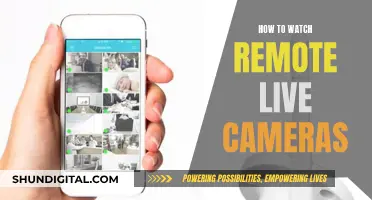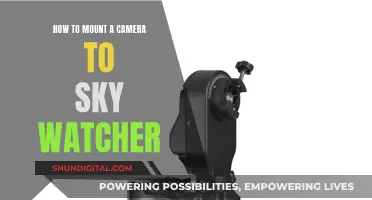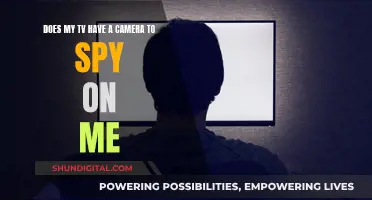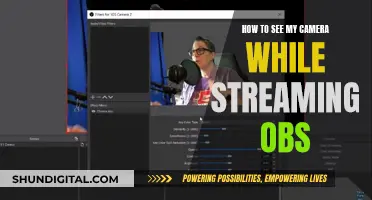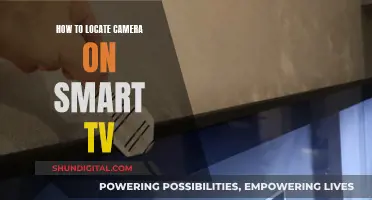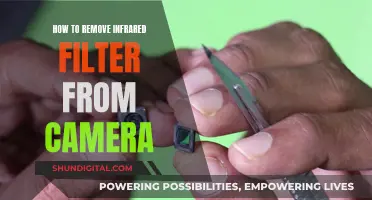
The Roomba i7+ is iRobot's most expensive and advanced Roomba model, with a host of features that make it a cut above the rest. One of its USPs is its top-mounted camera, which it uses to map out your home and improve its cleaning patterns. The camera collects feature data about your home to generate a map through VSLAM (visual simultaneous localization and mapping). This allows the Roomba i7+ to remember the layout of your home and clean in a smarter and more efficient way.
What You'll Learn

The Roomba i7+ camera uses VSLAM to map your home
The Roomba i7+ is iRobot's fanciest, most expensive addition to its Roomba robot vacuum line. The Roomba i7+ uses VSLAM (Visual Simultaneous Localization and Mapping) to map your home. The Roomba i7+ has a top-mounted camera that collects feature data about your home to generate a map. The camera allows the Roomba to "see" and uses its vision to clean better. The camera-based navigation system helps the Roomba to see and avoid furniture, socks, and other things on the floor. The camera also helps the Roomba to create a better map of your home.
The Roomba i7+ uses VSLAM to create a map that persists between cleaning sessions. This means that the robot remembers your floor layout and can plan accordingly the next time you ask it to clean. The Roomba i7+ can save the maps it creates and use them to improve its cleaning patterns. The robot will clean an entire room before moving on to the next one, and if its battery runs low or its bin fills up before it’s finished, it will remember where it stopped and return to that spot when it’s recharged. The Roomba i7+ can also identify which floor it is on and load the appropriate maps.
The Roomba i7+ is an update to iRobot’s high-end Roomba 980, which was capable of mapping a space and efficiently cleaning it, but would discard the maps after each cleaning session and rebuild them from scratch every time. The Roomba i7+ can now save the maps it creates and use them to improve its cleaning patterns. The Roomba i7+ can also be controlled by a voice assistant or from a smartphone app anywhere in the world.
Finding TV Cameras: Techniques for Spotting Hidden Lenses
You may want to see also

The camera doesn't record video or images
The iRobot Roomba i7+ is a smart vacuum that can map your entire house, be controlled by a voice assistant, and even empty its own bin. It uses a top-mounted camera to collect data about your home to generate a map through VSLAM (visual simultaneous localization and mapping). This allows the robot to remember the layout of your home and clean in a smarter and more efficient way.
While the camera on the Roomba i7+ enables the device to see and understand its surroundings, it is important to note that the camera does not record video or images. The iAdapt Localization Camera, used in some iRobot vacuums, is designed specifically for mapping out your home to ensure complete coverage. It does not have the capability to record or store any videos or images, and iRobot does not share any data with third parties. This ensures the safety and privacy of users.
The Roomba i7+ uses its camera to create a map of your home, which it then uses to navigate and clean efficiently. It does not use the camera to record or store any visual information. This is a common feature among robot vacuums, as most new cleaning bots use their cameras primarily for navigation and mapping purposes. Some bots use their cameras to constantly collect data as they clean, while others take a snapshot approach, mapping the area and storing that image in their memory.
The camera on the Roomba i7+ is an essential tool for its navigation and mapping capabilities, but it does not record or store any video or image data. This ensures that your privacy is protected while the device operates in your home. The device uses advanced technology to provide a smarter and more efficient cleaning experience without compromising your safety and privacy.
While the Roomba i7+ does not record or store any visual data, it is important to note that some robot vacuums have raised concerns about data sharing and security. Some providers do store and sell user data, so it is crucial to review the privacy policies and practices of any device before purchasing. Additionally, any device connected to your home's internet has the potential to be hacked, although the risk is lower if no videos or images are stored.
Stop TV Banding: Adjust Camera Settings for Better Quality
You may want to see also

The camera helps the Roomba i7+ avoid furniture and other obstacles
The Roomba i7+ uses a camera to help it navigate and avoid obstacles. The camera is part of the iRobot's iAdapt® Localization system, which is used to map out your home to ensure complete coverage. The camera collects feature data about your home to generate a map through VSLAM (visual simultaneous localization and mapping). This allows the Roomba i7+ to "see" and avoid furniture, socks, and other objects on the floor.
The camera-based navigation system helps the Roomba i7+ create a better map of your home and navigate more efficiently. It can identify landmarks on the ceiling and judge the distance between walls, allowing it to create a map as it cleans. This map is then used to improve its cleaning patterns and ensure it covers the entire floor.
The Roomba i7+'s camera also helps it to identify and avoid obstacles such as furniture. It can map the location of furniture and other objects in your home, and adjust its path accordingly. This is particularly useful if you move furniture or reconfigure a space, as the Roomba i7+ will adjust its map the next time it runs a cleaning job.
The camera on the Roomba i7+ is constantly collecting data as it cleans, allowing it to learn the locations of items in your home. This means that it won't run into objects that are moved or new objects that are introduced to the space. Overall, the camera helps the Roomba i7+ navigate and avoid furniture and other obstacles, making it a more efficient and effective cleaning robot.
Stream Setup: Viewing Your Camera Feed While Broadcasting
You may want to see also

The camera helps the Roomba i7+ identify high-pile carpets
The Roomba i7+ is a robot vacuum that can map your entire house. It can be controlled by a voice assistant or a smartphone app from anywhere in the world. It can even empty its bin into a larger bin in its charging base. The Roomba i7+ uses a top-mounted camera that collects feature data about your home to generate a map through VSLAM (visual simultaneous localization and mapping). The camera on the Roomba i7+ helps the robot vacuum identify high-pile carpets.
The camera on the Roomba i7+ uses VSLAM to identify high-pile carpets by distinguishing them from other objects and surfaces in its path. The camera collects data about the height and texture of the carpet, which helps the robot vacuum to avoid getting stuck or tangled in the carpet fibres. This data also helps the Roomba i7+ to adjust its cleaning pattern and suction power to effectively clean high-pile carpets.
The Roomba i7+'s camera can identify high-pile carpets by recognizing patterns and textures that are unique to this type of carpet. The camera can distinguish between different types of surfaces, such as hardwood floors, tiles, and carpets, and adjust its cleaning pattern accordingly. The camera's ability to identify high-pile carpets helps the Roomba i7+ to navigate and clean more efficiently.
The camera on the Roomba i7+ also helps the robot vacuum to avoid obstacles and hazards that are often associated with high-pile carpets. For example, the camera can detect if there are any objects or toys hidden in the carpet that could be a tripping hazard for the robot vacuum. The camera's ability to see and identify potential hazards helps the Roomba i7+ to navigate around high-pile carpets safely and effectively.
Overall, the camera on the Roomba i7+ plays a crucial role in identifying high-pile carpets and ensuring that the robot vacuum can clean them effectively and safely. The combination of VSLAM technology and the camera's ability to recognize patterns and textures enables the Roomba i7+ to provide a more efficient and satisfying cleaning experience for its users.
Self-Driving Cars: What Do Their Cameras Actually See?
You may want to see also

The Roomba i7+ camera can be hacked
The Roomba i7+ is a smart home gadget that can be used to clean floors without the heavy lifting of a traditional vacuum cleaner. It has a camera that helps it map out your home and clean the floors efficiently. While the camera does not record or store any videos, it is possible for the Roomba i7+ camera to be hacked.
Any device connected to your home's internet has the ability to be hacked if connected to your home's Wi-Fi. In the case of the Roomba i7+, this means that hackers could potentially control your robot vacuum, get network information, and access the footage as it cleans. This is a concern because it could allow unauthorized access to your home and personal information.
There are a few ways to mitigate the risk of being hacked. One way is to check the privacy and security features of the device before purchasing it. Another way is to keep the robot vacuum's app up to date to get all the latest security and privacy features. Additionally, if you decide to sell or get rid of your robot vacuum, performing a factory reset will help erase any data or settings that may be stored.
While the risk of being hacked is always present, taking these precautions can help reduce the likelihood of it happening. It is important for users of smart home devices to be aware of the potential risks and take the necessary steps to protect their privacy and security.
There is a robust community of Roomba hackers who have created a variety of projects to modify the device. These projects include turning the Roomba into a printer, making it remote-controlled, and adding new features like Alexa support. While some of these hacks may be fun and functional, they could also potentially introduce new security risks. It is important for users who choose to modify their Roomba to be aware of these risks and take appropriate precautions.
Night Vision Camera: Which Colors Are Invisible?
You may want to see also
Frequently asked questions
The camera on the Roomba i7 uses VSLAM (visual simultaneous localization and mapping) to map out your home and ensure complete coverage.
No, the Roomba i7 does not record or store any videos or images.
Yes, any device connected to your home's Wi-Fi can be hacked. However, since the Roomba i7 does not store videos or images, it is less likely that you will encounter issues with footage being accessed.
Yes, you can contact the provider to request that your data is not shared. Additionally, you can check the privacy settings of the mobile app to ensure that your data is only accessible to you.
The Roomba i7's camera is similar to other robot vacuum cameras in that it is used for mapping and navigation. However, one unique feature of the Roomba i7 is its ability to save maps and use them to improve cleaning patterns.


